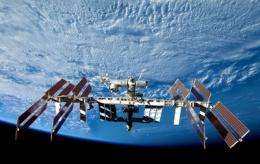Critics doubt value of International Space Station science

After the White House decided recently to prolong the life of the International Space Station until 2024, the nation's top science official declared that the four-year extension would help NASA get a big return on its $100 billion investment.
The station is "proving to be an amazingly flexible laboratory," said John Holdren, chief science adviser to President Barack Obama.
Yet despite his endorsement, critics ranging from space bloggers to official NASA watchdogs say the agency still has work to do before the station reaches its scientific potential.
"The old adage is that if you build it, they will come," said Keith Cowing, a former NASA space station payload manager who runs the popular website NASA Watch. "Well, it's there, but NASA has a lot of catching up to do in terms of fully utilizing the capability of the space station."
Billed as the "largest spacecraft ever built," the football-field-sized observatory began in 1998 with the launch of a bus-sized module from Russia. Since then, the station's two major partners - the U.S. and Russia - have steadily added pieces and equipment, along with contributions from Japan, Canada and Europe.
Astronauts have lived there continuously since 2000, but as recently as 2008 crew members were spending only about three hours a week on science. Now NASA officials say it's up to about 50 hours a week, due largely to the crew size doubling from three to six members in 2009. But about 15 percent of the U.S. racks for experiments onboard the station sat empty as of Dec. 31, and in a report issued last July, NASA's internal watchdog raised questions about the "real world" benefit of station science.
"A vast majority of the research activities conducted aboard the ISS have related to basic research as opposed to applied research," wrote investigators for NASA's inspector general.
It's the difference, they noted, between figuring out the biology of life in space and developing "more efficient materials" for products that could be used on Earth.
"While discoveries made as a result of basic research may eventually contribute to 'real world' applications, investors and for-profit companies may be reluctant to allocate funds to basic research - especially when the likelihood of profitable results is unknown," the authors added.
Much of the research done so far on the station has focused on astronaut health, and that's partly by design. More than 200 space travelers have visited the station since 2000, and the steady flow has provided NASA scientists with plenty of test subjects to study risks to the body - from muscle atrophy to vision problems.
In a recent speech, NASA Administrator Charlie Bolden said this kind of research would be necessary if NASA were ever to attempt a crewed mission to Mars.
"From a NASA perspective, the ISS is absolutely essential to the goals of sending humans to Mars in the 2030s," Bolden said.
But the focus on astronaut health also has exposed NASA to criticism about whether the station can benefit the 7 billion people living on Earth. Aware of this concern, NASA officials last year released a list of the top 10 research results that have stemmed from station experiments.
They include the development of treatments for osteoporosis to finding ways to monitor water quality from space - an approach that has been tried by the U.S. Environmental Protection Agency.
"Two things that we really need to share with everyone are that the space station is up there with humans working on orbit and that it is bringing back concrete benefits for use here on Earth," wrote Julie Robinson, chief scientist for the station, in a blog post touting the facility's accomplishments.
In an interview, she added that there are plans to do more. "There is a real demand for doing the studies of rodents," Robinson said.
Not only are mice already desirable for testing new drugs, she said, but space has a way of suppressing the immune system - which means drug companies can more effectively gauge how well their experimental treatments are working on infected rodents.
There are plans to blast 20 mice into space later this year, and Robinson said her long-term goal is to have "mice on every flight."
Another way NASA has tried to better use the station was hiring a nonprofit group in 2011 to manage the part of the station designated as a U.S. national laboratory and to entice non-NASA researchers to do their work there.
But the Florida-based group - the Center for the Advancement of Science in Space, or CASIS - had early management problems and was able to get its first sponsored payload onboard the station just this month.
A major obstacle is cost. The price of getting an experiment to the station can exceed $250,000, and that has made many researchers wary - even though CASIS often helps defray the expense with grants.
Another problem is interest. Although the microgravity environment is helpful for some experiments, such as crystal growth, CASIS executives said they are trying to educate other scientists - including those in the field of Earth observation - that the station can help them, too.
"We're at a time where we have to demonstrate the value of the asset," said Duane Ratliff, CASIS' chief operating officer. "We have to hurry up and really show the value."
©2014 The Orlando Sentinel (Orlando, Fla.)
Distributed by MCT Information Services



















